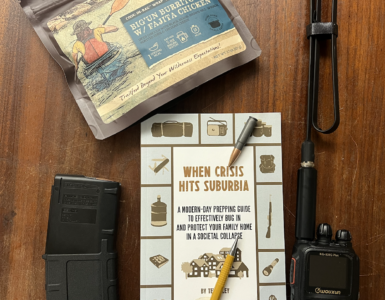By Steve | PrepperDeals.com
When the grid goes down, everything changes. Your fridge stops humming, your fans stop turning, and you’re left wondering what to do with a cooler full of melting groceries. That’s why every serious prepper needs a solid blackout kit—a power plan you can trust when the lights go out.
Today, we’re diving into the gear that keeps the essentials running: solar lanterns, rechargeable fans, power banks, and mini solar generators. More importantly, we’ll break down the real math behind keeping your fridge alive, your phone charged, and your sanity intact during extended blackouts.
What Goes in a Blackout Kit?
At a minimum, your blackout kit should include:
- ✅ Solar lanterns for room lighting
- ✅ Rechargeable headlamps and flashlights
- ✅ USB-powered fans to beat the heat
- ✅ Battery banks for phones and radios
- ✅ Mini solar generators to keep larger devices alive
- ✅ Cables, adapters, and backup charging cords
- ✅ Lighter and long burning (100 hour) candles
That’s your base kit. But if you want to keep a fridge or freezer running during a summer outage? You’re going to need to level up.
How Much Power Do You Really Need?
Let’s say your main goal is to keep a refrigerator running. Here’s what you need to know:
- Modern fridge power draw: ~100 to 800 watts, depending on size, age, and efficiency
- Average daily energy use: ~1.5 kWh to 2 kWh (1,500–2,000 watt-hours per day)
This means your battery bank needs to store at least 2,000 watt-hours just to keep the fridge cold for 24 hours—and that’s assuming mild temps and no door opening.
⚠️ Pro tip: During an outage, keep the fridge closed as much as possible. Every peek costs power.
Choosing the Right Battery Bank
Most solar generators and battery banks list their capacity in watt-hours (Wh). Here’s how a few popular sizes compare:
| Battery Bank Size | Capacity | Fridge Runtime Estimate |
|---|---|---|
| 500Wh | 500Wh | 6–8 hours (intermittent use) |
| 1000Wh | 1kWh | 12–16 hours |
| 2000Wh | 2kWh | 24–30 hours |
These are rough estimates. Older or larger fridges will draw more. Newer Energy Star models might use less. Your actual mileage may vary.
What About Recharging With Solar?
Let’s say you have a 200W solar panel kit.
Here’s the math:
- 200W panel x 5 sun hours/day = 1,000Wh (1kWh) per day
- That’s about half of what’s needed to run a fridge for a full day
So what’s the answer?
- ☀️ Pair your 200W panel with multiple panels or larger battery storage
- 🔄 Use two batteries and swap them: one charges while the other runs
- 🎯 Or only run the fridge intermittently (e.g., every 2 hours) to conserve power
⚡ Real-World Strategy: If you can’t store 2kWh or generate that much each day, your best move is to cool the fridge fully in the morning, then unplug it and replug every 2–3 hours. It won’t be ideal—but it’ll keep food from spoiling.
Should You Use Two Batteries?
Yes—if you can afford it, a two-battery rotation system is a game-changer.
- 🔁 Battery A runs the fridge during the day/night
- ☀️ Battery B recharges on solar during peak sunlight hours
- 📦 Swap every 12–24 hours to keep power flowing
This gives you flexibility, reduces stress, and builds redundancy into your system.
Other Gear Worth Including
Here are some overlooked gems that shine during summer outages:
- Rechargeable USB fans – draw 5W or less and provide hours of relief
- Solar-powered lanterns – charge in daylight and last all night
- LED headlamps – hands-free lighting for chores, cooking, and repairs
- Crank radios – stay updated when the grid and Wi-Fi go down
- Power station with AC outlets and DC ports – gives you more options for devices
Want to go deeper? Look for solar generators with pass-through charging so you can charge and use power at the same time.
Bottom Line: Build for Reality, Not Fantasy
If your blackout plan starts with “run everything like normal,” you’re going to be disappointed—and hot, and hungry. But if your plan is to power just the essentials and rotate loads intelligently, you’ll be in a much better spot.
Keep it simple. Stay cool. And remember: at PrepperDeals, we’re not just selling gear. We’re helping folks like you build smart, affordable systems that actually work when things go sideways.
🛒 Ready to Build Your Kit? Check out our latest deals on:
- Solar generators
- Portable panels
- Battery banks
- Blackout-ready LED fans and lights
Stay prepped, – Steve


















